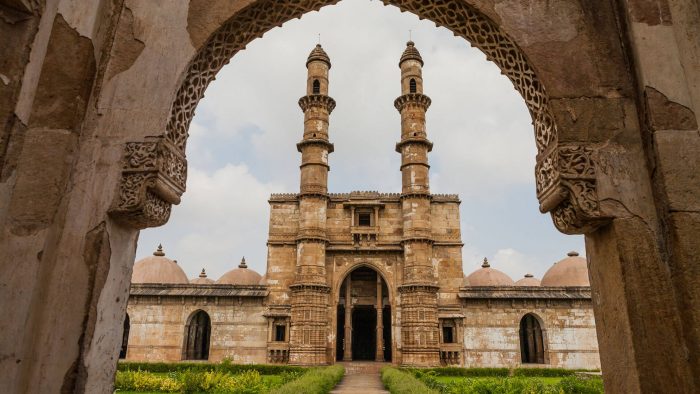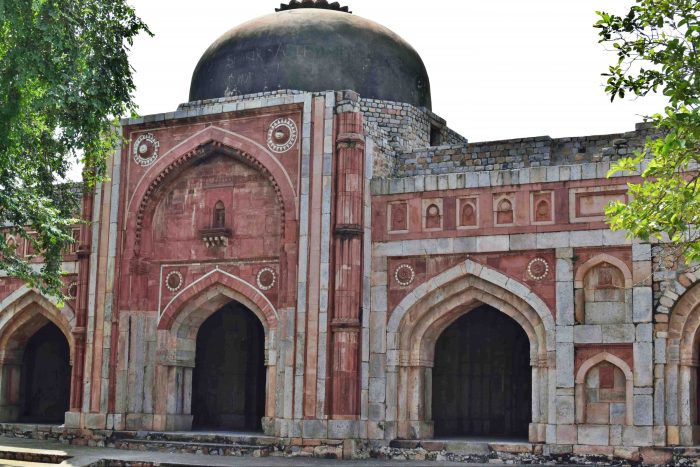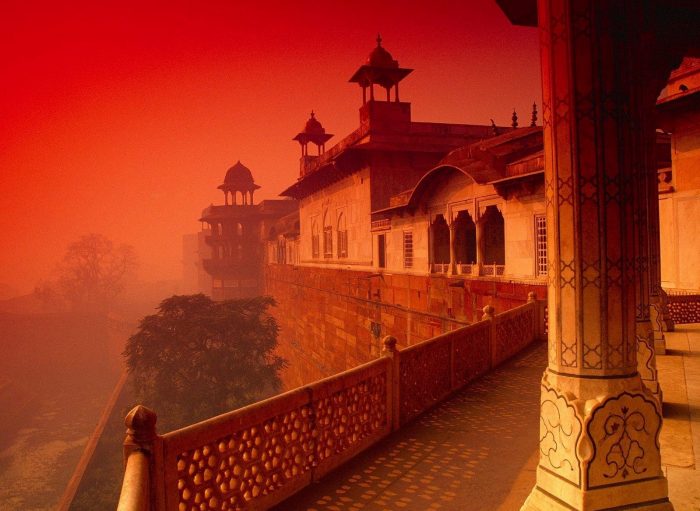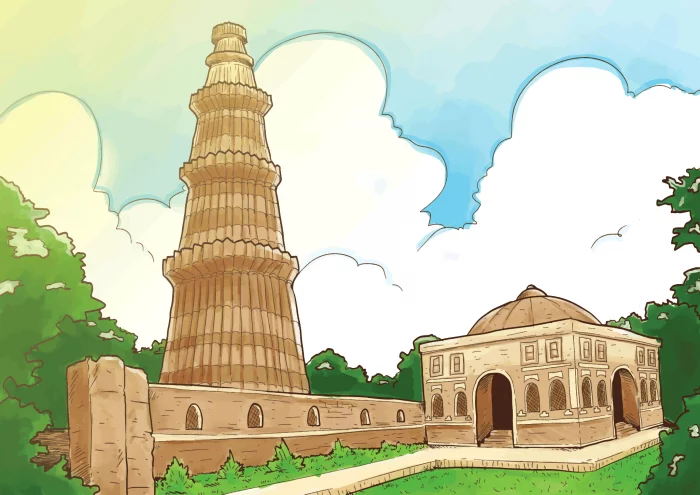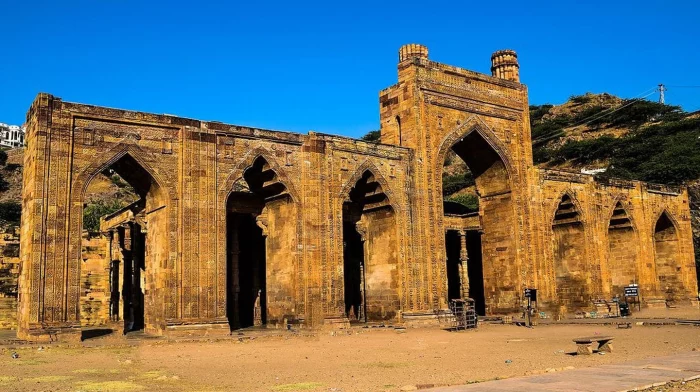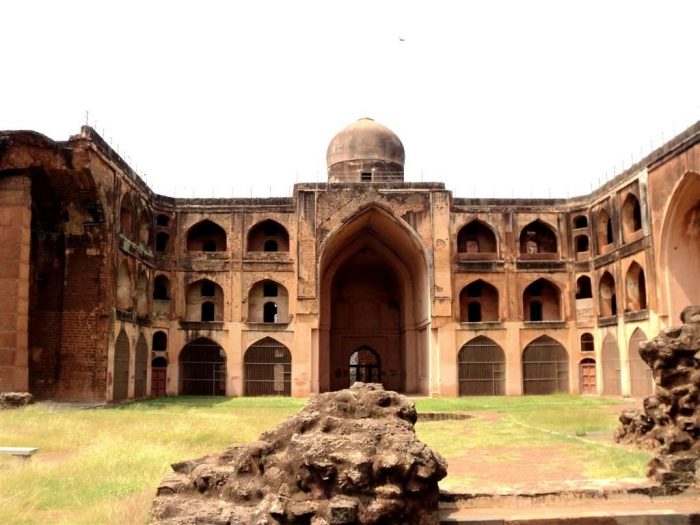Islamic architecture in India was created throughout the Middle Ages when various architectural styles as Persian and Central Asian, were combined under the power and influence of Muslim kingdoms. This period’s development of Muslim architectural style, known as Indo-Islamic architecture or Indian architecture, was influenced by Islamic art.
The Mughal Empire, which ruled India for over three centuries, was responsible for introducing Islamic architecture to India. The Indo-Islamic architectural style was neither entirely Islamic nor Hindu; it was instead a fusion of Indian and Islamic architectural components. It was characterized by simplicity and firmness in their structures, extensively using patterns and handwriting in designing their layouts.
One of the most famous Islamic architectural features used in this blend between the two cultures was qibla, mihrab, minbar, courtyards, minarets, arches, domes, and arabesque patterns.
Characteristics of Islamic architecture in India:
With the arrival of Islamic rulers, Indian architecture experienced a massive change; new architectural elements were introduced due to the confluence of Islamic and Indian factors. Some of these striking and unique characteristics are:
1) Calligraphy:
They were used for decoration, along with the arabesque technique that involved the usage of intricate geometrical designs.
2) Mortar:
They were utilized in their buildings as a cementing material.
3) Arches and Domes:
Employed in replacing the Trabeate architectural style, which depended mainly on constructing with beams and columns.
4) Charbagh style of gardening:
In which a square block is divided into four similar adjacent gardens.
5) Water:
Water was significant in Islamic constructions and utilized for cooling, decorative, and religious causes.
Along with these characteristics, many features came in the way, such as Jaali works which allowed lights into their constructions. Another example was the foreshortening technique used in buildings to make them appear closer than they are. Finally, the Pietra Dura and Mosaic designs used exquisitely produced, precisely cut, and fitted gemstones.
Also read:- How Did Scandinavian Architecture Master Simplicity While Persisting Luxury?
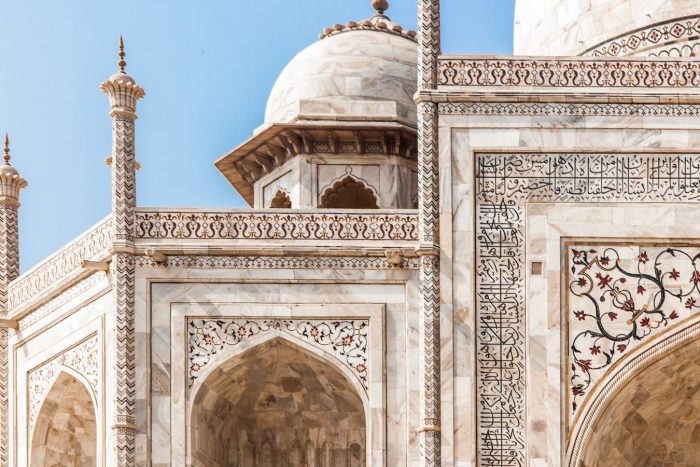
A literal depiction of the fusion of Islamic and Indian architectural components. © www.danflyingsolo.com
Popular examples of Islamic architecture in India
Speaking of which, Islamic architecture employed many constructions in Indian architecture characteristics, varying from mosques, forts, tombs, and other different structures which displayed the previous elements mentioned, which we’re showing as follows:
1) Charminar:
This well-known mosque was constructed by Muhammad Quli Qutb Shah in 1591 AD and is considered the beating heart of Hyderabadis. The Charminar is a square-shaped building of granite and lime mortar surrounded by four 48.7-meter-tall minarets on each corner. The building is two floors tall, while the minarets each have four feet. The side of the structure is open to broad courtyards, with four arches facing the principal directions, showing the blend of Islamic and Hindu architecture, as the decoration was influenced by Hindu architecture. In contrast, the arches and domes were inspired by Islamic architecture.
2) Jamali Kamali Mosque and Tomb:
A masterpiece mosque built by Sheikh Fazal in 1528-29 AD. The Jamali Kamali is a square building with a flat top with a partition that holds the tombs of a 16th-century Sufi saint named Jamali and his lover Kamali. Crafted by red sandstone and marble design, a dome rises from the top of the center arch of the prayer hall’s five carved-out arches painted beautifully in red and blue with circular towers displaying calligraphic quranic inscriptions to add beauty to its aesthetic appeal.
Also read:- Paris Architecture: The Remodeling of a Demolished City into a Polished One
3) Agra Fort:
A substantial red sandstone fort on the Yamuna River’s banks in 1565 was constructed by the orders of Emperor Akbar. The fort was primarily constructed as a military fort, further built by his grandson Shah Jahan. It is a 1.5-mile-long, 70-foot-tall crescent-shaped tower with a ditch surrounding it. A 21.4 m high defensive wall surrounds the fort, which is semicircular. The fort has two entrances: the Amar Singh Gate (looking south) and the Delhi Gate (facing west), which was the fort’s original entrance.
4) Qutub Minar:
In 1199, a tower of glory rising to 73 meters in height named Qutub Minar was constructed to celebrate Islamic dominance in India after the defeat of Delhi’s last Hindu kingdom. The minar has a height of 72.5 m, a base diameter of 14.3 m, and a top diameter of 2.7 m.
From top to bottom, there are 379 steps in the minar. The outside walls of the minar feature carvings that depict construction milestones. The intricate carvings combine traditional local creative styles with an Afghani design. Red sandstone is the primary building material for the first three floors; other than this, sandstone and marble were utilized as building materials.
5) Adhai din ka Jhonpra:
A mosque that is said to be built within two and a half days by order of Mohammad Ghori, the name of the mosque indicates a shed of two and half days. The mosque’s location housed a sizable Hindu school and temple that were destroyed and turned into a mosque whose architecture was inspired by an Islamic structure.
The mosque has two entrance gates consisting of 124 pillars; 92 are on the eastern side, and 64 are on the other side. Seven arches were built using yellow limestone, with tiny openings allowing sunlight to pass through. The tallest of which is 60 feet tall. The other six are smaller, with phrases from the Holy Quran written.
6) Mahmud Gawan Madrasa:
Constructed under the Bahmani Sultanate, this ancient Islamic college is a devotion to Mahmud Gawan, a tremendous intellectual and a Persian merchant. The structure was well-known for its artwork and superb architecture, giving the impression that Islamic architecture was present. The floral decor, arabesque design, and decorative inscriptions with arches containing verses from the Holy Quran dominating everywhere make it an exemplary illustration of Islamic architecture. The inscription also includes verses from the Quran with delicate tilework enfolding the main gate.
Islamic architecture has had a vast influence on Indian architecture. It had the power to inspire and influence the art, architecture, and lifestyle of the Indian people, flourishing in Medieval India under the patronage of different empires, holding a critical position that affected the architectural development in Indian architecture until today.


